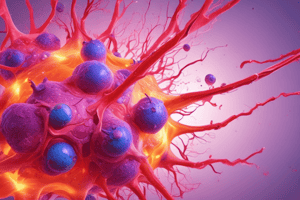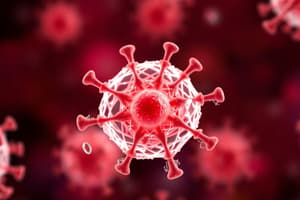Podcast
Questions and Answers
Which of the following is NOT a common indicator of acute inflammation?
Which of the following is NOT a common indicator of acute inflammation?
What is the main purpose of inflammation in the body?
What is the main purpose of inflammation in the body?
What happens when blood vessels near an affected area dilate during inflammation?
What happens when blood vessels near an affected area dilate during inflammation?
What are some common causes of acute inflammation?
What are some common causes of acute inflammation?
Signup and view all the answers
How does inflammation contribute to swelling?
How does inflammation contribute to swelling?
Signup and view all the answers
Which of the following is NOT an example of an acute inflammatory process?
Which of the following is NOT an example of an acute inflammatory process?
Signup and view all the answers
What is the term used to describe the difficulty in moving inflamed areas?
What is the term used to describe the difficulty in moving inflamed areas?
Signup and view all the answers
Which of the following is NOT a cause of inflammation as mentioned in the text?
Which of the following is NOT a cause of inflammation as mentioned in the text?
Signup and view all the answers
What characteristic of inflammation may lead to pain sensations due to nerve conduction disruptions?
What characteristic of inflammation may lead to pain sensations due to nerve conduction disruptions?
Signup and view all the answers
Which of the following is a stimulus that can elicit an inflammatory response in the body?
Which of the following is a stimulus that can elicit an inflammatory response in the body?
Signup and view all the answers
How do physical injuries contribute to inflammation according to the text?
How do physical injuries contribute to inflammation according to the text?
Signup and view all the answers
When certain chemicals or environmental agents come into contact with susceptible individuals, what can they trigger?
When certain chemicals or environmental agents come into contact with susceptible individuals, what can they trigger?
Signup and view all the answers
Study Notes
Unraveling Inflammation: Acute Inflammation, Signs, and Causes
Inflammation is a vital part of our body's immune response, helping protect us from harmful pathogens like bacteria and viruses. Understanding this process encompasses exploring its different forms, identifying common indicators, and uncovering factors contributing to its initiation. Let's delve into these aspects with respect to acute inflammation.
Acute Inflammation
Acute inflammation refers to an immediate immune reaction following tissue damage by trauma, infection, irritants, or allergies. This type of inflammation typically lasts for several days before naturally resolving itself. Common examples of acute inflammatory processes include sunburn, bruising, and fever due to bacterial infections such as pneumonia or gastroenteritis.
Signs of Inflammation
The human body employs various physical manifestations to indicate ongoing inflammation. These telltale symptoms can help healthcare professionals diagnose specific conditions. Some key features signaling inflammation include:
- Localized redness (rubor) — blood vessels near the affected area dilate, resulting in visible reddening of the skin.
- Heat production (calor) — the increased blood flow to the affected region elevates its temperature above normal levels.
- Swelling (tumor)— inflammatory cells release chemical mediators called prostaglandins which cause fluid accumulation inside tissues, leading to swellings.
- Loss of function (dolor) — damaged tissues often lead to pain sensations due to nerve conduction disruptions.
- Impaired movement capabilities (functio laesa) — inflamed areas may become difficult to move, exacerbating the patient's condition.
Causes of Inflammation
Several stimuli can elicit inflammatory responses within our bodies. The most prominent sources encompass:
- Trauma – Physical injuries result in cellular damages which activate nearby immune cells to initiate repair mechanisms.
- Pathogen invasion – Bacteria, viruses, parasites, or fungi enter our organisms through ingestion, inhalation, or direct contact; prompting an immune system mobilization against invaders.
- Irritant exposure – Certain chemicals or environmental agents, including pollutants and allergens, can trigger localized inflammation when they come into contact with susceptible individuals.
Understanding inflammation's characteristics and mechanisms helps medical practitioners devise effective strategies to combat underlying diseases causing acute inflammation. Moreover, it sheds light on potential preventive measures one could adopt to avoid unwanted health complications arising out of chronic inflammation.
Studying That Suits You
Use AI to generate personalized quizzes and flashcards to suit your learning preferences.
Description
Explore the realm of acute inflammation by delving into its signs, common causes, and distinct characteristics. Gain insights into how the body responds to trauma, infections, and irritants through immune reactions and inflammatory processes.




